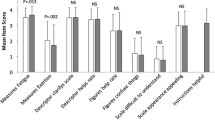Abstract
This study determined whether persons with coronary risk factors have increased fatigue during or after exercise. Ratings of perceived exertion were first shown to be a valid measure of fatigue; i.e., ratings of perceived exertion correlated with heart rate both during and after exercise and at each of three exercise tests (all within-subjects r>0.88). Physical inactivity and smoking were associated with increased fatigue. Inactive men and smokers had higher levels of fatigue during both exercise and recovery conditions and at each of three exercise tests. The increased fatigue of men who were inactive and smoked was not entirely due to their lower level of fitness. The risk factors of age, Type A behavior pattern, blood pressure, serum cholesterol, serum high-density lipoprotein, and obesity were not associated with increased fatigue. The increased fatigue experienced by inactive persons and smokers may account for their decreased compliance to exercise programs.
Similar content being viewed by others
References
Andrews, G. M., and Parker, J. O. (1979). Factors related to dropout of postmyocardial infarction patients from exercise programs.Med. Sci. Sports 11: 376–378.
Bar-or, O., Skinner, J. S., Buskirk, E. R., and Borg G. (1972). Physiological and perceptual indicators of physical stress in 41 to 60 year old men who vary in conditioning level and body fatness.Med. Sci. Sports 4: 96–100.
Borg, G., and Linderholm, H. (1967). Perceived exertion and pulse rate during graded exercise in various age groups.Acta Med. Scand. 472: 194–206.
Borg, G., and Linderholm, H. (1970). Exercise performance and perceived exertion in patients with coronary insufficiency, arterial hypertension and vasoregulatory asthma.Acta Med. Scand. 187: 17–26.
Borg, G. A. V., and Noble, B. J. (1974). Perceived Exertion. In Wilmore, J. H. (ed.),Exercise and Sports Sciences Review, Academic Press, New York, pp. 131–153.
Bruce, R. A. (1972). Multi-stage treadmill test of submaximal and maximal exercise. InExercise Testing and Training of Apparently Healthy Individuals: A Handbook for Physicians, American Heart Association, New York, pp. 32–34.
Carver, C. S., Coleman, A. E., and Glass, D. C. (1976). The coronary-prone behavior pattern and the suppression of fatigue on a treadmill test.J. Person. Soc. Psychol. 33: 460–466.
Dishman, R. K. (1982). Compliance/adherence in health-related exercise.Health Psychol. 1: 237–267.
Ekblom, B., and Goldbarg, A. N. (1971). The influence of physical training and other factors on the subjective rating of perceived exertion.Acta Physiol. Scand. 83: 399–406.
Gutmann, M. C., Squires, R. W., Pollock, M. L., Foster, C., and Anholm, J. (1981). Perceived exertion-heart rate relationship during exercise testing and training in cardiac patients.J. Card. Rehab. 1: 52–59.
Kramer, H. C. (1978). Individual and ecological correlation in a general context.Behav. Sci. 23: 67–72.
Martin, J. E., and Dubbert, P. (1982). Exercise applications and promotion in behavioral medicine: Current status and future directions.J. Consult. Clin. Psychol. 50: 1004–1017.
Mikevic, P. M. (1981). Sensory cues for perceived exertion: A review.Med. Sci. Sports Exer. 13: 150–163.
Multiple Risk Factor Intervention Trial Research Group (1982). Multiple risk factor intervention trial. Risk factor changes and mortality results.JAMA 248: 1465–1477.
Multiple Risk Factor Intervention Trial Group (1979). The MRFIT behavior pattern study 1.J. Chron. Dis. 32: 293–305.
Myrsten, A. L., Elgerot, A., and Edgren, B. (1977). Effects of abstinence from tobacco smoking on physiological and psychological arousal levels in habitual smokers.Psychosom. Med. 39: 25–38.
Noble, B. J. (1979). Validity of perceptions during recovery from maximal exercise in men and women.Percept. Motor Skills 49: 891–897.
Oldridge, N. B. (1979a). Compliance of post-myocardial infarction patients to exercise programs.Med. Sci Sports 11: 373–375.
Oldridge, N. B. (1979b). Compliance with exercise programs. In Pollock, M. L., and Schmidt, D. H. (eds.),Heart Disease and Rehabilitation, Houghton Mifflin, Boston, pp. 619–626.
Oldridge, N. B. (1982). Compliance and exercise in primary and secondary prevention of coronary heart disease: A review.Prevent. Med. 11: 56–70.
Oldridge, N. B., Wicks, J. R., Hamley C., Sutton, J. R., and Jones, N. L. (1978). Noncompliance in an exercise rehabilitation for men who have suffered a myocardial infarction.Can. Med. Assoc. J. 18: 361–364.
Pandolf, K. B. (1978). Influence of local and central factors in dominating rated perceived exertion during physical work.Percept. Motor Skills 46: 683–698.
Patton, J. F., Morgan, W. P., and Vogel, J. A. (1977). Perceived exertion of absolute work during a military physical training program.Eur. J. Appl. Physiol. 36: 107–114.
Ross, M. A. (1977).The Perception of Effort in Adult Males Possessing Either the Type A or Type B Behavior Pattern, Dissertation, University of Wisconsin—Madison, Madison.
Sanne H., Elmfeldt, D., Grimby, G., Ryden, G., and Wilhelmsen, L. (1973). Exercise tolerance and physical training of non-selected patients after myocardial infarction.Acta Med. Scand. Suppl. 551.
Schlegel, R. P., Wellwood, J. K., Copps, B. E., Gruchow, W. H., and Sharatt, M. T. (1973). The relationship between perceived challenge and daily symptom reporting in Type A vs. Type B post-infarct subjects.J. Behav. Med. 5: 191–204.
Skinner, J. S., Hustler, R., Bergsteinova, V., and Buskirk, E. R. (1973). Perception of effort during different types of exercise and under different environmental conditions.Med. Sci. Sports 5: 110–115.
Taylor, H. L., Jacobs, D. R., Schucker, B., Knudsen, J., Leon, A. S., and Debacker, G. (1978). A questionnaire for the assessment of leisure time physical activities.J. Chron. Dis. 31: 741–755.
Turklin, K. B., Zamlic, B., and Regan, U. (1977). Exercise performance and perceived exertion in patients after myocardial infarction. In Borg, G. (ed.),Physical Work and Effort, Pergamon Press, New York, pp. 357–366.
Author information
Authors and Affiliations
Additional information
This research was supported by NHLBI Training Grant 5T32 HL07328-04 (Dr. Hughes), NHLBI Research Career Development Award 5K04 HL00287 (Dr. Jacobs), and University of Minnesota Grant BRSG 2-507-RR-05448-20 (Dr. Jacobs).
Rights and permissions
About this article
Cite this article
Hughes, J.R., Crow, R.S., Jacobs, D.R. et al. Physical activity, smoking, and exercise-induced fatigue. J Behav Med 7, 217–230 (1984). https://doi.org/10.1007/BF00845388
Accepted:
Issue Date:
DOI: https://doi.org/10.1007/BF00845388




